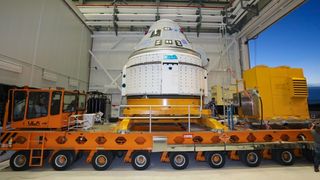Boeing's Starliner spacecraft is back in the factory to fix stuck valves
There's no new launch date yet for Orbital Flight Test 2.

Boeing's Starliner astronaut taxi has returned to its factory so engineers can fix stuck valves that were discovered recently as the company prepared to launch an uncrewed test flight for NASA.
The spacecraft was scheduled to launch on an uncrewed Orbital Flight Test 2 mission to the International Space Station on July 30 using a United Launch Alliance (ULA) Atlas V rocket. NASA and Boeing announced they would stand down from the launch attempt July 29, and with the stuck valves persisting, Starliner is undergoing what could be a lengthy fix.
Starliner is at the Commercial Crew and Cargo Processing Facility on NASA’s Kennedy Space Center, the agency announced last week. Before the facility shift, engineers removed the spacecraft from the Atlas V inside the Vertical Integration Facility at Space Launch Complex-41 on Cape Canaveral Space Force Station in Florida, which is nearby Kennedy.
"The team now will perform propulsion system checkouts inside the factory’s hazardous processing area and determine the appropriate vehicle configuration for accessing and analyzing the system further," NASA stated on its commercial crew blog. "NASA and Boeing will recommend forward work as part of a formal process designed to aid in determining root cause and remediation steps."
In photos: Boeing's Starliner OFT-2 mission in pictures
A new launch date for Orbital Flight Test 2 hasn't yet been announced, as that will be pending the results of the troubleshooting, NASA said, along with figuring out the right time to launch to the ISS amid other cargo and crew launches.
It's been a long road to certify Starliner to eventually carry astronaut crews. Boeing made an attempt in December 2019 for an uncrewed flight. Starliner launched successfully, but could not reach the ISS due to a series of technical glitches.
Get the Space.com Newsletter
Breaking space news, the latest updates on rocket launches, skywatching events and more!
After the Starliner splashdown, Boeing undertook a lengthy troubleshooting process with NASA, identifying and addressing dozens of problems. COVID-19 and a severe power outage in Texas added more delays in 2020 and 2021.
NASA's other commercial crew vehicle, SpaceX Crew Dragon, began running regular flights to the space station in 2020. Commercial crew is the replacement vehicle series following NASA's space shuttle, which retired in 2011 after 30 years of service. The agency used the Russian Soyuz spacecraft exclusively for astronauts until 2020 and has bought a few more Soyuz seats while waiting for Starliner to be ready.
Even after both commercial crew vehicles are operational, NASA and Russia may continue to fly each other's crew members, although that arrangement (at least as of April) is pending further discussion.
Follow Elizabeth Howell on Twitter @howellspace. Follow us on Twitter @Spacedotcom and on Facebook.
Join our Space Forums to keep talking space on the latest missions, night sky and more! And if you have a news tip, correction or comment, let us know at: community@space.com.

Elizabeth Howell (she/her), Ph.D., is a staff writer in the spaceflight channel since 2022 covering diversity, education and gaming as well. She was contributing writer for Space.com for 10 years before joining full-time. Elizabeth's reporting includes multiple exclusives with the White House and Office of the Vice-President of the United States, an exclusive conversation with aspiring space tourist (and NSYNC bassist) Lance Bass, speaking several times with the International Space Station, witnessing five human spaceflight launches on two continents, flying parabolic, working inside a spacesuit, and participating in a simulated Mars mission. Her latest book, "Why Am I Taller?", is co-written with astronaut Dave Williams. Elizabeth holds a Ph.D. and M.Sc. in Space Studies from the University of North Dakota, a Bachelor of Journalism from Canada's Carleton University and a Bachelor of History from Canada's Athabasca University. Elizabeth is also a post-secondary instructor in communications and science at several institutions since 2015; her experience includes developing and teaching an astronomy course at Canada's Algonquin College (with Indigenous content as well) to more than 1,000 students since 2020. Elizabeth first got interested in space after watching the movie Apollo 13 in 1996, and still wants to be an astronaut someday. Mastodon: https://qoto.org/@howellspace